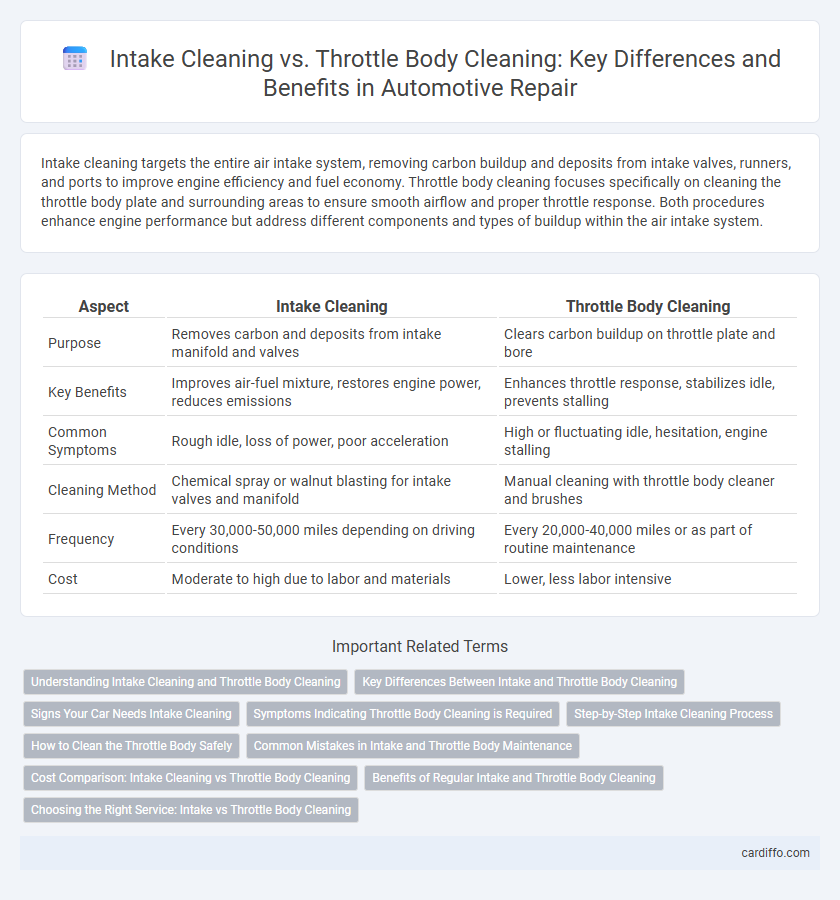Intake cleaning targets the entire air intake system, removing carbon buildup and deposits from intake valves, runners, and ports to improve engine efficiency and fuel economy. Throttle body cleaning focuses specifically on cleaning the throttle body plate and surrounding areas to ensure smooth airflow and proper throttle response. Both procedures enhance engine performance but address different components and types of buildup within the air intake system.
Table of Comparison
| Aspect | Intake Cleaning | Throttle Body Cleaning |
|---|---|---|
| Purpose | Removes carbon and deposits from intake manifold and valves | Clears carbon buildup on throttle plate and bore |
| Key Benefits | Improves air-fuel mixture, restores engine power, reduces emissions | Enhances throttle response, stabilizes idle, prevents stalling |
| Common Symptoms | Rough idle, loss of power, poor acceleration | High or fluctuating idle, hesitation, engine stalling |
| Cleaning Method | Chemical spray or walnut blasting for intake valves and manifold | Manual cleaning with throttle body cleaner and brushes |
| Frequency | Every 30,000-50,000 miles depending on driving conditions | Every 20,000-40,000 miles or as part of routine maintenance |
| Cost | Moderate to high due to labor and materials | Lower, less labor intensive |
Understanding Intake Cleaning and Throttle Body Cleaning
Intake cleaning targets the entire air intake system, removing carbon deposits and debris from intake valves, ports, and runners to improve airflow and combustion efficiency. Throttle body cleaning specifically addresses buildup on the throttle plate and housing, enhancing throttle response and preventing rough idling. Proper maintenance of both intake and throttle body components ensures optimal engine performance and fuel economy.
Key Differences Between Intake and Throttle Body Cleaning
Intake cleaning targets the entire air intake system, removing carbon deposits from the intake manifold, valves, and intake ports to improve overall airflow and engine efficiency. Throttle body cleaning is more focused, addressing buildup on the throttle plate and bore to restore proper throttle response and idle stability. The key difference lies in the scope, with intake cleaning offering a broader engine cleaning while throttle body cleaning zeroes in on the throttle's mechanical components.
Signs Your Car Needs Intake Cleaning
Signs your car needs intake cleaning include rough idling, decreased engine performance, and poor fuel efficiency caused by carbon buildup restricting airflow. A clogged intake manifold often results in engine misfires and hesitation during acceleration, while throttle body cleaning mainly targets the throttle plate and surrounding area to improve idle stability rather than overall intake airflow. Regular inspection of intake valves and manifold deposits is crucial to maintaining optimal engine function and preventing costly repairs.
Symptoms Indicating Throttle Body Cleaning is Required
Rough idling, stalling, and hesitation during acceleration are common symptoms indicating throttle body cleaning is required. A dirty throttle body often causes poor engine performance and reduced fuel efficiency due to obstructed airflow. Unlike intake cleaning, which targets carbon buildup in the intake manifold and valves, throttle body cleaning specifically addresses grime affecting the throttle plate and sensor operation.
Step-by-Step Intake Cleaning Process
The step-by-step intake cleaning process involves first removing the intake manifold to access carbon buildup inside the intake ports and valves. Next, specialized intake cleaning solvents are applied to dissolve deposits, followed by thorough scrubbing or using walnut shell blasting for stubborn carbon. Finally, the manifold is reinstalled, ensuring gaskets are replaced to maintain an airtight seal, improving engine performance and fuel efficiency compared to throttle body cleaning alone.
How to Clean the Throttle Body Safely
To clean the throttle body safely, first disconnect the battery to avoid electrical hazards and remove the air intake duct for clear access. Use a throttle body cleaner spray and a soft brush or cloth to gently remove carbon deposits, avoiding harsh scrubbing that can damage sensors or delicate components. Reassemble the parts carefully and reconnect the battery, then start the engine to allow the ECU to recalibrate the throttle position sensor.
Common Mistakes in Intake and Throttle Body Maintenance
Common mistakes in intake and throttle body maintenance include neglecting regular cleaning intervals, leading to carbon buildup that hampers engine performance. Using improper cleaning agents can damage delicate sensors and coatings within the throttle body and intake manifold. Failure to inspect and replace faulty gaskets or seals often results in vacuum leaks, causing rough idling and decreased fuel efficiency.
Cost Comparison: Intake Cleaning vs Throttle Body Cleaning
Intake cleaning typically costs between $150 and $300, involving the removal of carbon deposits from the intake valves and ports, which can be labor-intensive and requires specialized equipment. Throttle body cleaning tends to be less expensive, averaging around $75 to $150, as it primarily focuses on cleaning the throttle body plate and bore to improve airflow and engine response. Choosing between the two services depends on the vehicle's symptoms and the extent of carbon buildup, with intake cleaning offering a more comprehensive but costlier solution compared to throttle body cleaning.
Benefits of Regular Intake and Throttle Body Cleaning
Regular intake and throttle body cleaning enhances engine performance by preventing carbon buildup that restricts airflow and fuel efficiency. This maintenance reduces rough idling, engine hesitation, and improves acceleration response, contributing to smoother driving. Consistent cleaning extends engine life and lowers the risk of costly repairs by maintaining optimal combustion and reducing emissions.
Choosing the Right Service: Intake vs Throttle Body Cleaning
Choosing the right service between intake cleaning and throttle body cleaning depends on the vehicle's symptoms and engine performance issues. Intake cleaning targets carbon buildup within the intake manifold and valves to restore airflow and fuel efficiency, while throttle body cleaning focuses on removing deposits that cause rough idling or poor throttle response. Consulting a professional mechanic who can perform diagnostic tests ensures the precise service needed to optimize engine function and prevent future problems.
Intake cleaning vs Throttle body cleaning Infographic

 cardiffo.com
cardiffo.com